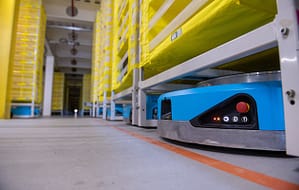Our world is becoming more and more automated, whether that be in our homes, leisure or in the workplace. One area where automation is proving extremely fruitful is in warehouses. Modern-day one-click shopping has left warehouse, distribution and fulfilment centres feeling the need for more streamlined logistics and to accommodate this, many e-commerce businesses are turning to smart automation systems.
These smart automation systems are becoming increasingly common in the manufacturing and logistics industries and are used for taking on the repetitive, laborious and often dangerous tasks that humans are perhaps not best placed to do. These are often carried out by collaborative robots, otherwise known as cobots.
What are cobots?
Cobots are by definition designed to work alongside humans to carry out repetitive, error-prone tasks. By doing so, they create a safer and more efficient workplace without actually eliminating the need for a human worker.
Cobots are becoming ever-popular. Before the COVID-19 pandemic, it was estimated that cobots will comprise 34% of total robot sales by 2025. They are more affordable than industrial robots because they operate at lower speeds and payloads. This makes them accessible for businesses of different sizes, meaning that they deliver a fast return on investment. They are small and lightweight enough that they can easily be moved and redeployed to automate different processes, putting versatility and cost-effectiveness on their side.
Cobots in warehouses
The job of warehouse picking has always been carried out by human workers. In a large scale warehouse, this can really take a toll on workers’ bodies and their schedule, spending more time walking long distances and travelling through the warehouse than actually doing the tasks that create revenue.
The introduction of cobots into warehouses, however, has meant that human workers can spend more time on productive tasks. Leading the way in this is Amazon. They have more than 200,000 mobile cobots working inside its warehouse network alongside thousands of human workers, allowing them to fulfil their promises of speedy deliveries to their Amazon Prime customers.
In a bid to keep up with these defined expectations, the rest of the retail warehouse industry is feeling the pressure to streamline their processes in the same way. This has resulted in many smaller businesses investing in cobots and exploring how this type of automation can take their service to the next level.
The opportunity for warehouses
The beauty of cobots is that they do not need to be complicated in order to effectively operate in a warehouse. They can be as simple as autonomous pallet jacks that follow a worker around the warehouse, or even wearable robotics that help employees with overhead work.
Because cobots cost much less to purchase and maintain than industrial robots, they offer up a world of possibility for smaller-scale operations. This allows them to keep up with customer expectations without having to stretch to afford complex automation systems.
Not only will cobots increase workplace efficiency, but they will also increase worker safety by helping to avoid ankle twists and sprains, lower back injuries and upper body fatigue – all common issues in warehouse workers.
Because cobots are specially designed to collaborate with human workers, they will never overpower or render them redundant. There are some requirements that a cobot just can’t deliver, such as picking up oddly shaped items or giving specialised finishes to shipments.
Cobots will always require human intervention with set-ups and programming in order to do their job, providing companies with the opportunity to upskill their workforces and focus time and resource on enabling them to undertake more skilled and value-adding activities.
Every business is on the table for automation – not just warehousing. Automation is changing the modern-day workplace for the better and in the next decade, we can expect to see the cobot sector boom. Similarly, today’s logistics landscape is set to only become more fast-paced, so e-commerce businesses must be agile. Warehouse cobots can help them keep up with these ever-increasing standards and expectations.






Leave a Comment